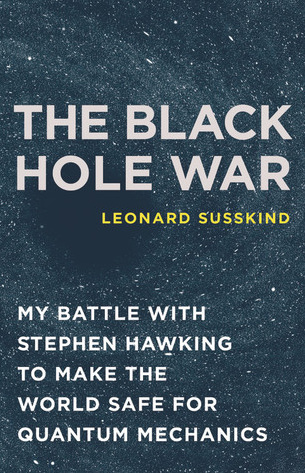

Leonard Susskind · 480 pages
Rating: (7.9K votes)
“There is a philosophy that says that if something is unobservable -- unobservable in principle -- it is not part of science. If there is no way to falsify or confirm a hypothesis, it belongs to the realm of metaphysical speculation, together with astrology and spiritualism. By that standard, most of the universe has no scientific reality -- it's just a figment of our imaginations.”
― Leonard Susskind, quote from The Black Hole War: My Battle with Stephen Hawking to Make the World Safe for Quantum Mechanics
“There is so much to groak; So little to groak from.”
― Leonard Susskind, quote from The Black Hole War: My Battle with Stephen Hawking to Make the World Safe for Quantum Mechanics
“the three-dimensional world of ordinary experience—the universe filled with galaxies, stars, planets, houses, boulders, and people—is a hologram, an image of reality coded on a distant two-dimensional surface. This new law of physics, known as the Holographic Principle, asserts that everything inside a region of space can be described by bits of information restricted to the boundary.”
― Leonard Susskind, quote from The Black Hole War: My Battle with Stephen Hawking to Make the World Safe for Quantum Mechanics
“Before World War II, when physics was primarily a European enterprise, physicists used the Greek language to name particles. Photon, electron, meson, baryon, lepton, and even hadron originated from the Greek. But later brash, irreverent, and sometimes silly Americans took over, and the names lightened up. Quark is a nonsense word from James Joyce’s Finnegan’s Wake, but from that literary high point, things went downhill. The distinctions between the different quark types are referred to by the singularly inappropriate term flavor. We might have spoken of chocolate, strawberry, vanilla, pistachio, cherry, and mint chocolate chip quarks but we don’t. The six flavors of quarks are up, down, strange, charmed, bottom, and top. At one point, bottom and top were considered too risqué, so for a brief time they became truth and beauty.”
― Leonard Susskind, quote from The Black Hole War: My Battle with Stephen Hawking to Make the World Safe for Quantum Mechanics
“Tides and the 2,000-Mile Man What causes the seas to rise and fall as if they were breathing two big breaths every day? It’s the Moon, of course, but how does it do it, and why twice a day? I will explain, but first let me tell you about the fall of the 2,000-Mile Man. Imagine the 2,000-Mile Man—a giant who measures 2,000 miles from the tip of his head to the bottoms of his feet—as he falls, feet-first, from outer space toward the Earth. Far out in outer space, gravity is weak—so weak that he feels nothing. But as he gets closer to the Earth, strange sensations arise in his long body—sensations not of falling but of being stretched. The problem is not the giant’s overall acceleration toward the Earth. The cause of his discomfort is that gravity is not uniform throughout space. Far from the Earth, it is almost entirely absent. But as he draws closer, the pull of gravity increases. For the 2,000-Mile Man, this presents difficulties even while he is in free fall. The poor man is so tall that the pull on his feet is much stronger than the pull on his head. The net effect is an uncomfortable feeling that his head and feet are being pulled in opposite directions. Perhaps he can avoid being stretched by falling in a horizontal position, legs and head at the”
― Leonard Susskind, quote from The Black Hole War: My Battle with Stephen Hawking to Make the World Safe for Quantum Mechanics

“Perhaps he can avoid being stretched by falling in a horizontal position, legs and head at the same altitude. Yet when the giant tries it, he finds a new discomfort; the stretching sensation is replaced by an equal feeling of compression. He feels as if his head is being pressed toward his feet. To understand why this is so, let’s temporarily imagine that the Earth is flat. Here is what it would look like. The vertical lines, together with the arrows, indicate the direction of the gravitational force—not surprisingly, straight down. But more than that, the strength of the gravitational pull is entirely uniform. The 2,000-Mile Man would have no trouble in this environment, whether he fell vertically or horizontally—not until he hit the ground anyway. But the Earth is not flat. Both the strength and the direction of gravity vary. Instead of pulling in a single direction, gravity pulls directly toward the center of the planet, like this: This creates a new problem for the giant if he falls horizontally. The force on his head and feet will not be the same because gravity, as it pulls toward the center of the Earth, will push his head toward his feet, leading to the strange sensation of being compressed. Let’s return”
― Leonard Susskind, quote from The Black Hole War: My Battle with Stephen Hawking to Make the World Safe for Quantum Mechanics
“Let’s return to the question of the ocean tides. The cause of the twice-daily rising and falling of the seas is exactly the same as the cause of the 2,000-Mile Man’s discomfort: the non-uniformity of gravity. But in this case, it’s the Moon’s gravity, not the Earth’s. The Moon’s pull on the oceans is strongest on the side of the Earth facing the Moon and weakest on the far side. You might expect the Moon to create a single oceanic bulge on the closer side, but that’s wrong. For the same reason that the tall man’s head is pulled away from his feet, the water on both sides of the Earth—near and far—bulges away from it. One way to think about this is that on the near side, the Moon pulls the water away from the Earth, but on the far side, it pulls the Earth away from the water. The result is two bulges on opposite sides of the Earth, one facing toward the Moon and the other facing away. As the Earth turns one revolution under the bulges, each point experiences two high tides. The distorting forces caused by variations in the strength and direction of gravity are called tidal forces, whether they are due to the Moon, Earth, Sun, or any other astronomical mass. Can humans of normal size feel tidal forces—for example, when jumping from a diving board? No, we cannot, but only because we are so small that the Earth’s gravitational field hardly varies across the length of our bodies. Descent”
― Leonard Susskind, quote from The Black Hole War: My Battle with Stephen Hawking to Make the World Safe for Quantum Mechanics
“By itself, the Holographic Principle was not enough to win the Black Hole War. It was too imprecise, and it lacked a firm mathematical foundation. The reaction to it was skepticism: The universe a hologram? Sounds like science fiction. The fictitious future physicist Steve passing to the “other side” while the emperor and the count watch him being immolated? Sounds like spiritualism.”
― Leonard Susskind, quote from The Black Hole War: My Battle with Stephen Hawking to Make the World Safe for Quantum Mechanics
“one of the key features of a black hole: different observers have paradoxically different perceptions of the same events. To”
― Leonard Susskind, quote from The Black Hole War: My Battle with Stephen Hawking to Make the World Safe for Quantum Mechanics
“From time to time, we hear physicists claim that Einstein didn’t understand Quantum Mechanics and therefore wasted his time with naive classical theories. I very much doubt that this is true. His arguments against Quantum Mechanics were extremely subtle, culminating in one of the most profound and most cited papers in all of physics.12 My guess is that Einstein was disturbed by the same thing that bothered the slow student. How could the ultimate theory of reality be about nothing more concrete than our own degree of surprise at the outcome of an experiment?”
― Leonard Susskind, quote from The Black Hole War: My Battle with Stephen Hawking to Make the World Safe for Quantum Mechanics

“I frowned. Evidently, Sangris wasn't a cat who could shape-shift. It was more difficult than that. He was a nothing who occasionally pretended to be a cat. "I wish I could know what it's like for myself, that's all," I said. I felt rather the way a jail inmate would if a bird flew up and shouted through her window bars: This freedom thing? Yeah, not so great.”
― Rinsai Rossetti, quote from The Girl with Borrowed Wings
“Westboro Baptist Church: STOP. Stop protesting the funerals of our soldiers who died in action because you are anti-gay. When one of you dies, I’m going to show up with a couple of gay veterans and we’re going to do a musical at your funeral.”
― Billy Crystal, quote from Still Foolin' 'Em: Where I've Been, Where I'm Going, and Where the Hell Are My Keys
“During the night she had told me, 'I feel old. I miss being young.' She curled her arms over her chest, looking already like all the dead Papillons I hade seen littering the grass beneath the sycamores on campus. Unlike any of the other Papillons, though, she was in my apartment, curled in my lap. I missed being young too. Only I had thousands of days to go.”
― Maggie Stiefvater, quote from The Curiosities: A Collection of Stories
“I wondered, what other gifts I got bottled up inside me? That question had started to gnaw on me some.”
― Susan Crandall, quote from Whistling Past the Graveyard
“If you went back far enough, Uncle Tinsley went on, just about”
― Jeannette Walls, quote from The Silver Star
BookQuoters is a community of passionate readers who enjoy sharing the most meaningful, memorable and interesting quotes from great books. As the world communicates more and more via texts, memes and sound bytes, short but profound quotes from books have become more relevant and important. For some of us a quote becomes a mantra, a goal or a philosophy by which we live. For all of us, quotes are a great way to remember a book and to carry with us the author’s best ideas.
We thoughtfully gather quotes from our favorite books, both classic and current, and choose the ones that are most thought-provoking. Each quote represents a book that is interesting, well written and has potential to enhance the reader’s life. We also accept submissions from our visitors and will select the quotes we feel are most appealing to the BookQuoters community.
Founded in 2023, BookQuoters has quickly become a large and vibrant community of people who share an affinity for books. Books are seen by some as a throwback to a previous world; conversely, gleaning the main ideas of a book via a quote or a quick summary is typical of the Information Age but is a habit disdained by some diehard readers. We feel that we have the best of both worlds at BookQuoters; we read books cover-to-cover but offer you some of the highlights. We hope you’ll join us.